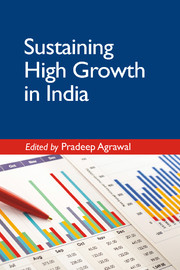Book contents
- Frontmatter
- Contents
- List of Tables
- List of Graphs and Maps
- Preface
- Introduction
- Section 1 Ensuring Macroeconomic Stability for Sustaining High Growth Rates
- Section 2 Promoting Industrial Development for Sustaining High Growth Rates
- Section 3 The International Economic Issues and Sustaining High Growth
- Section 4 Infrastructure Bottlenecks to Sustaining High Growth
- Section 5 Some Socio-political Issues in Sustaining High Growth
- List of Contributors
- Obituary
- Index
Preface
Published online by Cambridge University Press: 08 February 2018
- Frontmatter
- Contents
- List of Tables
- List of Graphs and Maps
- Preface
- Introduction
- Section 1 Ensuring Macroeconomic Stability for Sustaining High Growth Rates
- Section 2 Promoting Industrial Development for Sustaining High Growth Rates
- Section 3 The International Economic Issues and Sustaining High Growth
- Section 4 Infrastructure Bottlenecks to Sustaining High Growth
- Section 5 Some Socio-political Issues in Sustaining High Growth
- List of Contributors
- Obituary
- Index
Summary
India, one of the top five economies worldwide, is a young country. It has more than 65 per cent of its 1.3 billion population below 35 years of age. To realise the potential of this demographic dividend, the Indian economy must provide facilities for education, health and skill development to the population, especially the large sections of society that are poor, or who have fewer amenities. But India is a home to 18 per cent of the world's population and 30 per cent of it is poor – who live on less than $2 a day. Agriculture contributes only 14 per cent to the GDP, but employs more than 50 per cent of the population. There is much disguised unemployment, under-employment and inequality in the Indian economy. Reducing poverty and inequality is a massive challenge for policymakers and it requires a multi-pronged approach. First, the government must make enough investment in education, health, sanitation, and other physical and social infrastructure to improve the standard of living for a billion people. This requires resources from the exchequer. Second, the government must enable people to shift to the secondary and tertiary sectors from agriculture, where marginal productivity of labour is low or negligible, after creating a productive labour force through good education, skill development, training, and healthcare facilities. This requires improvement of investment ratios across sectors, particularly in manufacturing, for productivity-led growth and job creation. Third and the most important, it must create opportunities for the existing unemployed and under-employed and for the new labour force. Job creation must be the government's top priority. A million people join the workforce every month; in 2015, a dismal 1,35,000 jobs were created, according to the Employment Labour Bureau. Achieving and sustaining high growth and creating employment is an urgent necessity.
In the early 1990s, economic reforms began in India. Then predominantly agricultural, the economy is now service-led. But given the strong industry-service linkage, the service sector – which is not labour-intensive – cannot sustain itself without a vibrant, growing industrial sector or grow by depending only on the world market. Moreover, one cannot depend on agriculture, as half the labour force does, to improve the standard of living. To remain on a high-growth trajectory, there must be an increase in investment in industry and, in particular, manufacturing, which generates jobs for millions of semi-skilled, literate labourers.
- Type
- Chapter
- Information
- Sustaining High Growth in India , pp. xix - xxiiPublisher: Cambridge University PressPrint publication year: 2017



